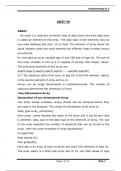Interview
New! Comprehensive C Language Notes 2023
- Vak
- Instelling
Comprehensive C Language Notes for Sale C Language Notes for Sale User Well in depth description about c language notes to sell ChatGPT Title: Comprehensive C Language Notes for Sale Introduction: Our comprehensive C Language notes offer a detailed and in-depth resource for individ...
[Meer zien]



